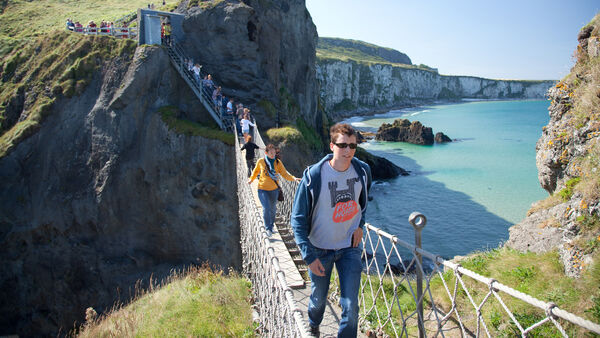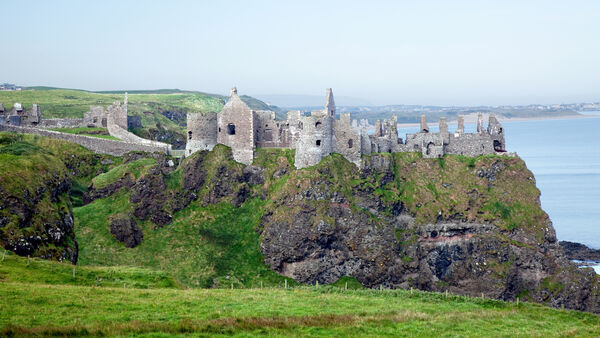A Day on the Antrim Coast, Ireland’s Scenic North


By Rick Steves and Pat O'Connor
While it's Northern Ireland's cities that grab headlines, the country has its share of rural beauty as well. The craggy 20-mile stretch of the Antrim Coast extending eastward from Portrush to Ballycastle rates second only to the tip of the Dingle Peninsula as the prettiest chunk of coastal Ireland.
It's a fairly small area, and with a car you can easily see its highlights in a day (connections are patchy by public transportation, and bus service is viable only in summer). An ideal day could lace together Dunluce Castle, Old Bushmills Distillery, and the Giant's Causeway, followed by nine holes on the Portrush pitch-and-putt course. You'll want the full day, though, so allow two nights in the town of Portrush, the region's hub.
Dunluce Castle
These romantic ruins, perched dramatically on the edge of a rocky headland, are a testimony to this region's turbulent past. During the Middle Ages, the castle was a prized fortification. But on a stormy night in 1639, dinner was interrupted as half of the kitchen fell into the sea, taking the servants with it. That was the last straw for the lady of the castle. The countess of Antrim packed up and moved inland, and the castle began its slow submission to the forces of nature.
While it's one of the largest castles in Northern Ireland and beautifully situated, there's precious little left to see among Dunluce's broken walls.
Before entering, catch the eight-minute video about the history of the castle (across from the ticket desk). The ruins themselves are dotted with plaques that show interesting artists' renditions of what the place would have looked 400 years ago.
Old Bushmills Distillery
Bushmills claims to be the world's oldest distillery. Though King James I (of Bible translation fame) only granted Bushmills its license to distill "Aqua Vitae" in 1608, whiskey has been made here since the 13th century. Distillery tours waft you through the process, making it clear that Irish whiskey is triple distilled — and therefore smoother than Scotch whisky (distilled merely twice).
The one-hour tour starts with the mash pit, which is filled with a barley porridge that eventually becomes whiskey. You'll see thousands of oak casks — the kind used for Spanish sherry — filled with aging whiskey. Visitors get a single glass of their choice. Those who don't want straight-up whiskey can ask for a cocktail, a hot toddy, or a nonalcoholic beverage.
To see the distillery at its lively best, visit when workers are staffing the machinery — Monday morning through Friday noon. (The still is still on weekends and in July). Book ahead online for tours, which can fill up in advance.
Giant's Causeway
This five-mile-long stretch of coastline — the highlight of the entire coast — is famous for its bizarre basalt columns. The shore is covered with largely hexagonal pillars that stick up at various heights. It's as if the earth were offering God his choice of 37,000 six-sided cigarettes.
Geologists claim the Giant's Causeway was formed by volcanic eruptions more than 60 million years ago. As the surface of the lava flow quickly cooled, it contracted and crystallized into columns (resembling the caked mud at the bottom of a dried-up lakebed, but with far deeper cracks). As the rock later settled and eroded, the columns broke off into the many stair-like steps that now honeycomb the Antrim Coast.
The Giant’s Causeway is actually free and open all the time. But in practice, anyone parking there needs to pay a fee, which includes an audioguide (or guided walk) and entrance to the visitor's center. (The visitors center's interactive exhibits give a worthwhile history of the Giant's Causeway.) You can visit the causeway either by a cheap shuttle bus or on foot (10 minutes from the visitors center to the first viewpoint, 15 level minutes farther to reach the Shepherd's Steps).
County Antrim is the Bible Belt of Northern Ireland. When a large supermarket chain decided to stay open on Sundays, a local reverend called for a boycott of the store for not honoring the Sabbath. And in 2012, when the Giant's Causeway Visitors Centre opened, local Creationists demanded that, alongside modern geologic explanations about the age of the unique rock formations, an exhibit be added explaining their viewpoint (that, according to the Bible, the earth here was only 6,000 years old — not 60 million — carbon dating be damned).
Carrick-a-Rede Rope Bridge
With a little more time — workable in the summer, when the long days this far north extend your sightseeing time — you could venture farther east for an exciting walk along this bridge. For 200 years, using just wooden planks, rope, and wire, fishermen strung a narrow, 100-foot-high bridge across a 60-foot-wide chasm between the mainland and a tiny island just east of the Giant's Causeway. Today, the bridge (not the original) gives access to the sea stack — and induces a giddy sensation in anyone afraid of heights. (Don't b-b-b-bounce!) A pleasant, 15-minute, half-mile walk from the parking lot takes you to the rope bridge. Once across on the wee island, explore. Very busy (and smelly) seabird cliffs face the mainland and bay; they're especially active during the summer nesting season.
Timed tickets are required to cross the bridge. Book online in advance, or arrive as early as possible; they sell only 240 tickets (same-day only) for each hour-long entry window. If you arrive on a busy day, you may have to wait an hour or even find that all the day's tickets are sold. Cruise groups and big buses arrive after 11:00. (If you're frustrated at the ticket booth, you're welcome to hike down to the bridge for free but won’t be able to venture onto it.)
Portrush
In the evening, return to Portrush, which retains the architecture of a once-genteel seaside resort but is far from its previous glory. Its peninsula is filled with lowbrow, family-oriented amusements, fun eateries, B&Bs, and more than its share of empty storefronts and abandoned old townhouses. Even so, Northern Ireland fun seekers happily come here in summer to promenade along the tiny harbor and tumble down to the sandy beaches that extend in sweeping white crescents.
If you're back well before dusk, visit the esteemed Royal Portrush Golf Club. On a summer evening, stroll Curry's Fun Park for its arcade games, roller coasters, or just a cotton-candy taste of Northern Ireland at play.
Pat O'Connor is the co-author of the Rick Steves Ireland guidebook.

